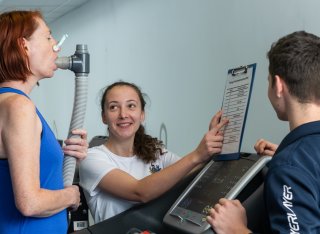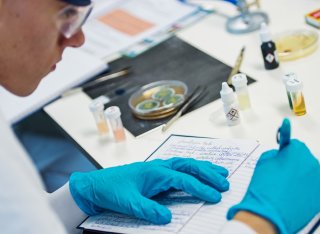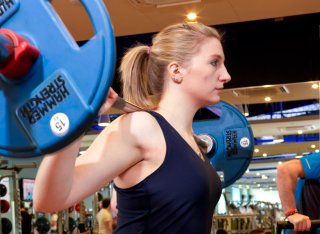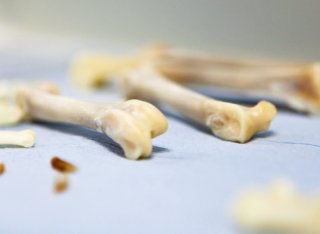

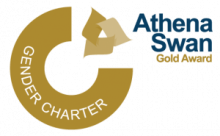
Facilities for students
Discover our multi-million-pound laboratories, fitted with industry-standard equipment, to prepare you for a scientific career.
Equipment, software and experiments
Find out what equipment and software each of our biosciences facilities contain and what experiments you can carry out with these.
Innovation for Health Learning Lab
This Lab will be where you’ll complete most of your undergraduate scientific practicals and can accommodate up to 200 students.
In the Lab, you’ll have access to:
- ADInstruments kits
- Balances
- Blood analysers
- Centrifuges
- Flame photometer
- Fume hoods
- Gel imagers
- Kjeldahl digestion block and distiller
- Light microscopes
- pH meters
- Pipettes
- Polymerase chain reaction (PCR) machines
- Soxhlet extraction system
- UV-Vis spectrophotometers.
Undergraduate
Year 1
In your first year, you’ll familiarise yourself with some of the basic equipment by completing introductory experiments. Depending on the modules you study, the other experiments you’ll complete will vary.
Bacteriology
- Carrying out serial dilution
- Enumeration techniques for bacteria
- Handling cultures
- Isolating bacteria
- Performing Gram stains
- Using diagnostic tests to identify groups of bacteria
Biochemistry
- Enzyme properties and the effect of substrate concentration
- Protein assay and standard curve generation
- Thin-layer chromatography
- Titrations and use of a pH meter
Cell Biology
- Histological staining
- Light microscopical examination of histological specimens
- Observation of dividing cells and their chromosomes
- Subcellular fractionation of cauliflower by differential centrifugation
Evolutionary Origins of Biodiversity
- Lake chemistry – turbidity, pH, nitrate an orthophosphate concentration, and dissolved oxygen, carbon dioxide and chlorophyll determination
- Microscopy and odentification of algae protozoa and planktonic life
- Sampling
Fundamental in Food Science, Nutrition and Microbiology: a practical approach
- Maillard reaction and caramelisation
- Starch-iodine interactions
- Starch hydrolysis and Thin Layer Chromatography interpretation
Microbiology
- Analysis of data
- Culture techniques
- Good microbiology practice
- Microscopy
Molecular Biology
- Gel electrophoresis
- PCR
- Using bacterial conjugation to illustrate the link between and organisms genotype and phenotype
Physiology
- Cardiovascular function
- Haematology – performing blood cell counts, measuring haematocrit and packed cell volume, and determining the ABO and rhesus blood groups of samples
- Lung function testing
Years 2 and 3
As you move into your second- and third-year studies, you’ll complete more complex experiments, that again vary depending on the modules you take:
Analytical Biochemistry
- Urinalysis for the investigation of clinical samples
Biomedical Microbial Products
- Screening and discovery of bioactive products
Cellular Microbiology and Virology
- Haemagglutination and haemagglutination inhibition assay
- Plaque assay
Energy and Lipid Metabolism
- Determination of total plasma cholesterol
- High-density lipoprotein cholesterol and triacylglycerol
Food Microbiology
- Food poisoning – outbreak investigation
- Meat microbiology
- Milk microbiology
- Yoghurt fermentation
Food Science
- Analysis of caffeine by high-performance liquid chromatography (HPLC)
- Chemical and physical characterisation of fats and oils
- Compositional analysis of sausage
- Determination of sugars
- Functional properties of starch
Introduction to Immunology
- Enzyme-linked immunosorbent assay (ELISA)
- Flow cytometry
Microbial Communities
- Antimicrobial resistance
- Dental biofilms and quorum sensing
- Environmental biofilms
Molecular Biology and Genetics
- Casting, running and visualising a gel, then analysing results
- Genomic PCR
- RNA isolation, quantification and reverse transcription polymerase chain reaction (RT-PCR)
Pathology and Medicine
- Functional properties of starch and sugar determination
- Food fraud detection by ELISA
Postgraduate
On our MSc courses, you’ll use the lab for practical skills training during Welcome Week.
On our Food Science MSc, you’ll use the lab for an antioxidant capacity assay as part of the Food Chemistry and Health module.
Human Movement Lab
If you’re studying sport and exercise-science-related modules, you’ll get to use our Human Movement Lab.
You’ll have access to specialised equipment, including:
- Delsys electromyography (EMG) systems
- Dynamometers
- Force plate treadmills
- Force plates.
You’ll also get to use Optojump and Qualisys software.
Using this equipment and software, you can:
- Track isometric and isokinetic movements by attaching EMG electrodes and measuring muscle activity (including using muscle stimulus), analyse muscular power and imbalances between limbs, and predict possible injuries.
- Complete 3D motion analysis looking at walking and running gait by using infrared cameras to track movements, then analyse movement variability.
- Investigate jump performance by looking at different jump types and the effect of strength and conditioning training.
- Test muscular power by performing isokinetic and isometric movements to measure muscle function and nerve function.
Exercise Physiology Lab
You’ll also have access to our Exercise Physiology Lab, if you’re studying sport and exercise-science-related modules.
You’ll get to use:
- A dry gas analyser
- A metabolic cart
- Biosen blood glucose-lactate analysers
- Douglas bags
- Monark Peak Bikes
- Servomex analysers
- Treadmills.
Using this equipment, you can:
- Complete a Wingate test to analyse the power output and the percentage drop off once maximal power is reached.
- Carry out VO2 max and sub maximal tests to see how efficiently participants use oxygen while completing exercise.
- Calculate lactate threshold by analysing glucose and lactate levels in the blood.
- Measure O2 and CO2 levels of expired air and volume
- Measurement of energy expenditure
- Measure the ergogenic effect of caffeine on exercise performance.
Food Research Lab
You’ll use this Lab if you’re conducting a nutrition research project as a final-year undergraduate or masters student.
You’ll get access to a:
- Colorimeter
- Soxhlet extraction system
- High-performance liquid chromatography (HPLC) system
- Kjeldahl system
- pH stat
- Rheometer
- Soxhlet
- Texture analyser
- Water activity meter.
If your project involves molecular biology techniques, you may also use our Tissue Culture Lab. This has a clinical chemistry analyser you can use to analyse the levels of various metabolites in human plasma.
Food and Nutrition Kitchen Lab
You’ll have access to this lab if you’re studying on one of our food science, nutrition and dietetics courses at undergraduate or masters level. You’ll develop your skills and understanding of food preparation, meal development, food hygiene and nutrition.
You’ll have access to:
- Ovens
- Induction hobs
- Microwave ovens
- Catering fridge and freezer
- Large food mixers
- Blenders
- Pasta makers
- Colourimeters
- Moisture analysers
- Water activity meter
- Kettles
- Precision balances
- Food pH meters
- Brix meters
- Hot plate stirrers
- Air fryers
- Whisks
- Ice cream maker
- Bread makers
- Tortilla maker
- Yoghurt maker.
Year 1
In your first year, you’ll use the Food and Nutrition Kitchen Lab for two modules.
Principles of Nutrition and Health:
- Plant-based diets – cooking and tasting different plant-based products, for example milk and other dairy products, egg alternatives, and fish and meat alternatives.
- Portion-size practical – understanding the use of portion sizes and measuring out average portion sizes of commonly encountered foods.
- Come Dine With Me – working in groups to produce a meal related to a specific ethnic diet. You will then eat together and present on the experience to a small group of peers.
Applied Skills in Nutrition:
- Meal modification – cooking and modifying recipes to reduce fat, saturated fat, salt and sugar, and increase fibre and protein, as well as modification to remove allergens. You’ll consider the nutritional implications of these modifications, assess sensory changes (e.g. texture, taste and smell), and consider elements like cost, sustainability, preparation time, and the skills required.
Year 2
In the second year of our Food Science and Nutrition BSc you’ll use the lab for the New Product Development module. This module is optional for our Nutrition BSc:
- Reformulating food products and understanding the functionalities of main ingredients (fats, carbohydrates, proteins). Developing aspects such as sugar and fat replacement in products.
If you’re studying our Nutrition and Dietetics BSc, you’ll use the lab for the Applied Dietetics module:
- Food fortification techniques – improving calorie and protein intake for individuals who struggle to maintain adequate oral intake. You will also use oral nutritional supplement drinks in recipes to improve palatability and compliance.
- Dysphagia practical with Wiltshire Farm Foods – you will be producing texture modified meals from ready-prepared Wiltshire Farm Foods products, reflecting on the process and taste-testing.
- Coeliac disease – preparing gluten free alternatives of different food products and comparing to their gluten containing versions.
Year 3
In your third year, you’ll have the option to use the lab for your research project, where you’ll reformulate and/or develop a new food product starting from conceptualisation to the finished product (previous examples include probiotic ice cream, high protein smoothies, seaweed bread, oleogel-based biscuits, carob-based sweet spreads, vegan butter and vegan coconut jam).
Masters students
On our MSc in Food Science, you’ll use the lab for the Food Processing and Development module:
- Food product development – you’ll create a food product from the ideation stage to finished product, and work on concepts such as reduction or replacement (e.g. sugar replacement) or formulation of different food matrices. You’ll also investigate functionalities of ingredients and understand their chemical interaction from the physico-chemical point of view.
- Research project – you’ll have the option to use the lab for your research project, where you’ll reformulate and/or develop a new food product starting from conceptualisation to finished product (previous examples include probiotic ice cream, high protein smoothies, seaweed bread, oleogel-based biscuits, carob-based sweet spreads, vegan butter and vegan coconut jam).
Ecotrophelia UK
The kitchen facility is key for the development of an eco-innovative new food product that students can submit to the Ecotrophelia competition. This prestigious competition is held yearly, involving teams from UK universities. The University of Surrey’s team has been successfully shortlisted in recent years, winning the competition in 2024, and going on to represent the UK in the European finals.
Human Research Unit
This is a dedicated space for masters and final-year undergraduate research projects in food science and nutrition.
- Clinical suite (with six hospital beds) for cannulating and taking serial venous blood samples, also capable of running sleep simulation studies
- Two indirect calorimeters for measurement of energy expenditure and substrate oxidation
- A small research laboratory for processing of biological samples
- Three clinical interview rooms
- A research kitchen
- Participant lounge with seating, tables and chairs
- Dedicated rooms for Dual X Ray absorptiometry (DXA) and pQCT – for analysis of bone and body composition
In the Human Research Unit, you can undertake diet and nutrition interventions, including post-prandial studies and metabolic measures as part of clinical trials.
Project Lab
You’ll get to use our 60-person Project Lab for your final-year undergraduate or integrated masters dissertation projects.
You’ll have access to basic molecular biology equipment, including:
- Balances
- Centrifuges
- CO2 incubators
- Gel imagers
- Heat blocks
- Horizontal and vertical gel running equipment
- Microscopes
- PCR machines
- pH meters
- Pipettes
- Power packs
- Spectrophotometers
- Water baths.
Using this equipment, you can carry out:
- Aseptic techniques looking at handling bacterial cultures, biofilms and antimicrobial resistance
- DNA manipulation and purification, preparation of agarose gels and DNA separation
- PCR reactions using a thermal cycler
- Preparation of media and buffers, and calculations of concentrations (%, M)
- RNA isolation, quantification and RT-PCR
- SDS-PAGE and Western blotting for separation and detection of proteins
- The Miles and Misra method, using a spectrophotometer to measure bacterial growth
- Tissue culture technique, microscopy and transfection of cells.
Take a facilities tour
Take a look around our state-of-the-art facilities with our undergraduate students Asini and Kate.
Course-specific facilities
Depending on your course, you may also get access to additional facilities.







